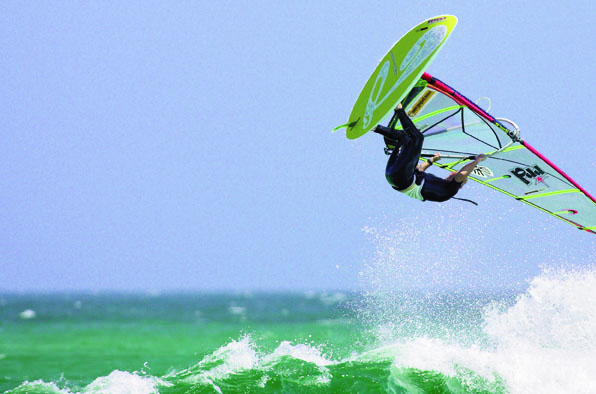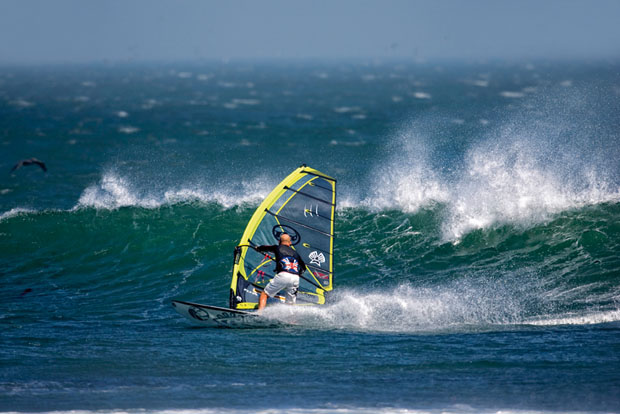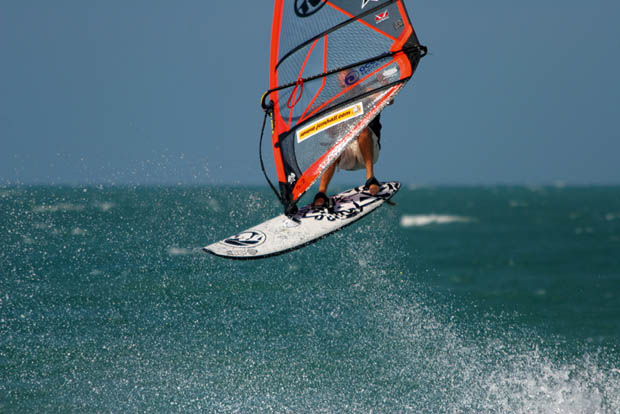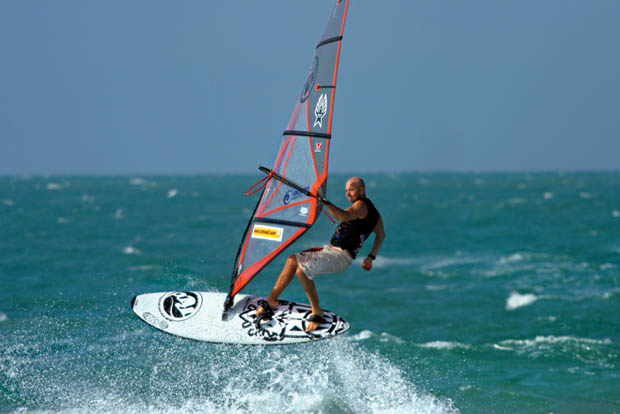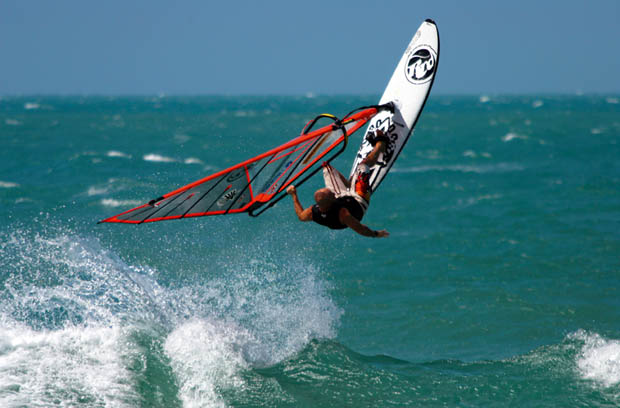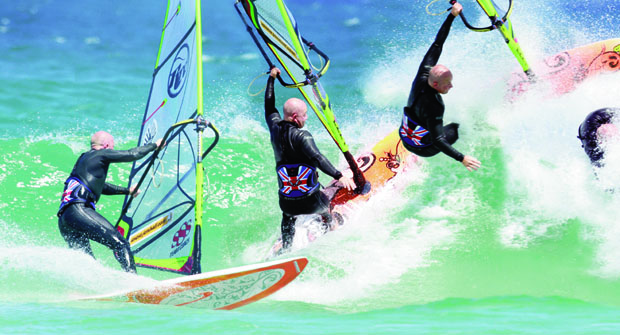
You will now be more confident in the wave environment – and, of course, looking to step it up a bit. The realisation that you have to take some beatings in order to become a wavesailor has now sunk in. If it hasn’t, then I suggest watching some pros or good sailors and witnessing the carnage that ensues. If you’ve seen any of the Cabo Verde footage then you’ll get what I mean – serious shit-eating mixed in with some superhuman performances. So, let’s examine how to bail out, what to do when getting pummelled, and basically how to survive.
Before going any further though, let’s just get something clear. Getting rinsed doesn’t hurt! It’s fun. OK, yes, if you’re getting washed over a neardry reef then that’s not fun. If you’re getting held down for two minutes at Jaws, that’s not fun. But in the sort of waves that beginner to intermediate wavesailors are out in, you’re not going to come to any harm at all. I’ve seen people pack up and go home after one decent rinse-and-swimashore; they really thought they had suffered something devastating. Yet actually, if they’d watched for a while, they’d have seen loads of people taking a rinsing but not thinking twice about it. They stayed relaxed, reunited themselves with their kit, and carried on sailing. It will happen to you, and it’s nothing to worry about. (Assuming you can swim. If you can’t, then wavesailing perhaps isn’t your ideal choice of pastime.) So, nothing to worry about – OK? But there is certainly plenty you can do to minimise the effects, and the energy outlay, of getting rinsed. All through this series I’ve emphasised the importance of having a gameplan. Prevention is definitely better than cure here! For example, if you’re getting savaged every time you try to get out and winning more awards for swimming than jumping, it’s probably time to reassess your tactics: • Are you on the right kit?
• Are you fit enough?
• Are you trying to get out in the right place?
• Have you selected the right route at the right time?
• Also – is anyone else getting out?
If you’ve picked a 5 knot day at big Brandon Bay and no-one else is on the water, it may be for a very good reason… But if other people are getting out and you’re not, watch them closely, considering the points above and why they’re working for them and not for you. Please look back at the getting out feature in the May ’07 issue right now to refamiliarise yourself with this topic.
So now you’re out and looking for a wave, you need to be thinking about the old mantra ‘right move, right time, right place’ more than ever, but now adding ‘right wave’ to the mix. What do you mean, you’ve forgotten already? Get yourself back to the June and July ’07 issues immediately and remind yourself about waveriding tactics. Got it? Good. Okay, so you’re now behaving impeccably and getting out and catching the right waves, so it’s time to cut loose, smack some sections and go for some stunts. Now we’re talking – but this will inevitably end in you in taking some punishment.
Surfival – Getting Out
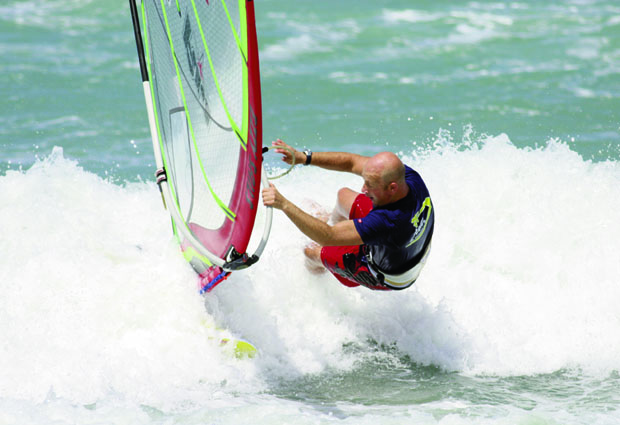
At some point soon, if it hasn’t happened already, you’ll meet a large wave or wall of white water and will not get over it. Or, as you’re struggling out, the wind will drop (usually at the worst possible moment) and you’ll find yourself in the water.
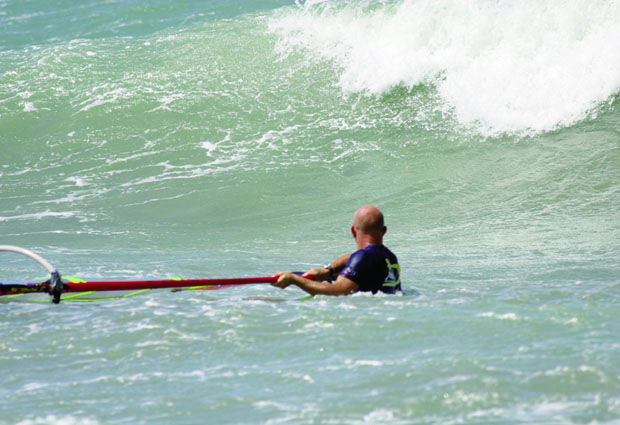
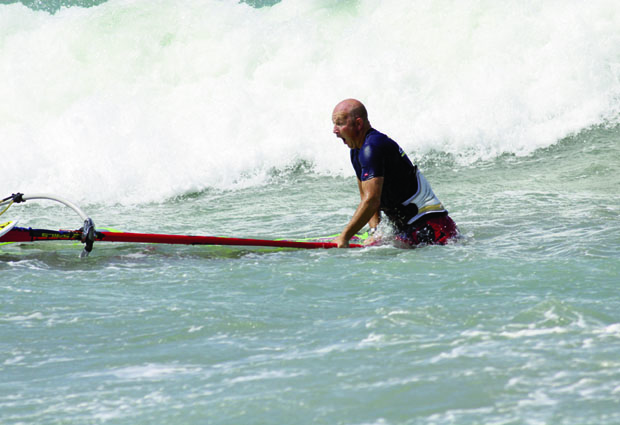
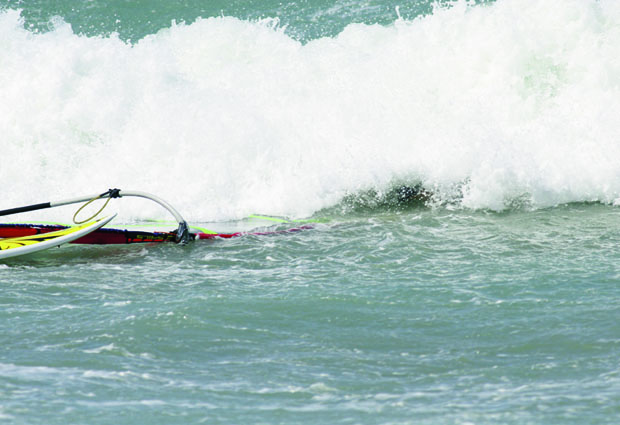
The most important thing is to keep hold of your gear if at all possible. If you get separated from it you’re in for a long swim. As the wall of white water (or vertical cresting wall) is bearing down on you, this should be your plan:
• Swim to the mast tip and take a good hold of it. (first pic in the sequence above)
• Position it so that it’s pointing into the wave.
• Take a breath and swim downwards, holding on to the mast tip to drag the top of the rig down into the water before the wave meets you, so that the wave breaks / washes over your rig rather than directly onto it, giving you some chance of holding on.
• Be ready to make a quick waterstart if it’s all clear. If not, get ready to take on the next wave.
• If you’re getting too heavily pounded, it’s all a bit too relentless and you’re heading towards sense-of-humour-failure time, then waterstart IN. There’s no point getting back on the board and heading out to sea with zero forward momentum if you’re just going to get hit by the next wall.
• If you’re waiting to waterstart then point the kit at the wave, keeping it all downwind of you. NEVER let the kit get between you and the wave! Thrust the nose towards the wave and keep that rig flying through extended arms.
• Eventually you will get some time to make an exit. This highlights the vital need for cardiovascular fitness. You will lose your kit and have to swim for it, and you will have to make quick and efficient waterstarts in shit wind and under pressure – plus the good old alligator rig wrestle will be taking place from time to time. But it can actually be quite fun water-skiing behind your kit as you’re dragged along with it!
Skye’s Beatings – What To Do When Getting Punished

General Tips
When crashing, always try to relax the body as much as possible. Your body is remarkably flexible if you let it be. Obviously try to get out of the straps and abort if you can, but if you do get stuck in the straps then go with the gear and let your body twist with the feet. In the white water with one foot in the strap you can sometimes twist around a couple of times underwater, but stay relaxed and extract the foot when you feel the pressure release.
Jumping Punishment
Keep your eyes open so you have a good idea of where you are and where your kit is. It’s hard to call, but sometimes it’s better to hold on and sometimes better to let go. In a forward, for example, letting go early normally means crashing into the gear, so you’re much better off holding on. (The pics are from the second part of a double.) I hold on to the boom until I know I am under the gear, and then let go. If you can, try to land compact with your feet first (you never really know how deep the water is) and try to cover the head.My technique is to crash feet first, get under the water, curl up into a ball (particularly protecting the face) and then wait a few seconds underwater for the kit to land. Normally it lands downwind, but sometimes it can land on top of you.
Riding / Wave Punishment
The most important thing when getting washed is to relax. If you fight it you’ll run out of oxygen a lot quicker.My technique is to relax, cover my face / head as best as possible and then just count. You’ll probably be thrown around a lot, so stay relaxed and when everything stops try to swim to the surface. I personally keep my eyes open as long as it’s not sandy. Counting helps you realise that, although it feels like an eternity, it’s probably only about five seconds! Hold on to the gear if you can, but be aware of what you’re holding on to. The back end of booms, for example, can sometimes rip fingers apart. Also if the gear twists you may need to let go to avoid your body getting either caught between the gear, or pushed against the seabed.
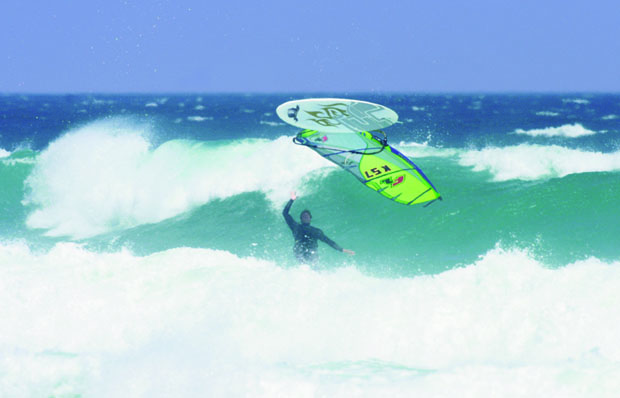
Bailing Out:
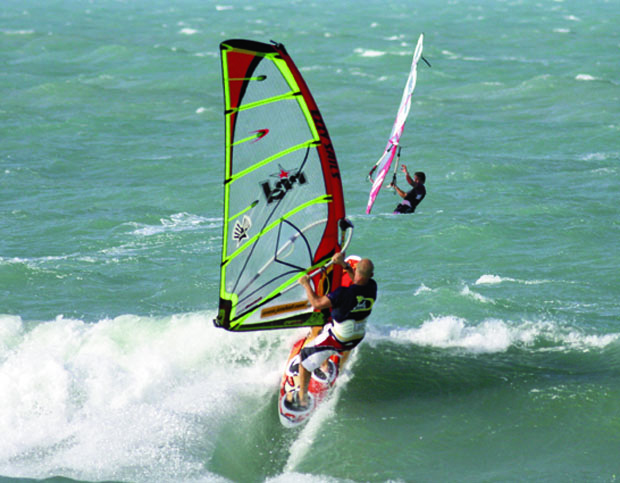
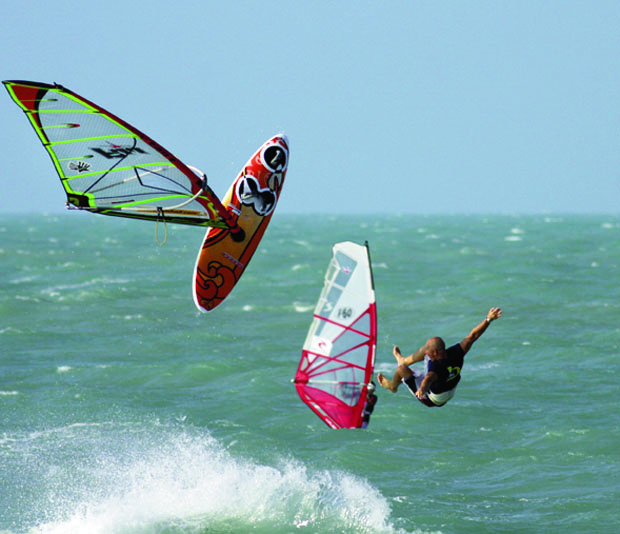
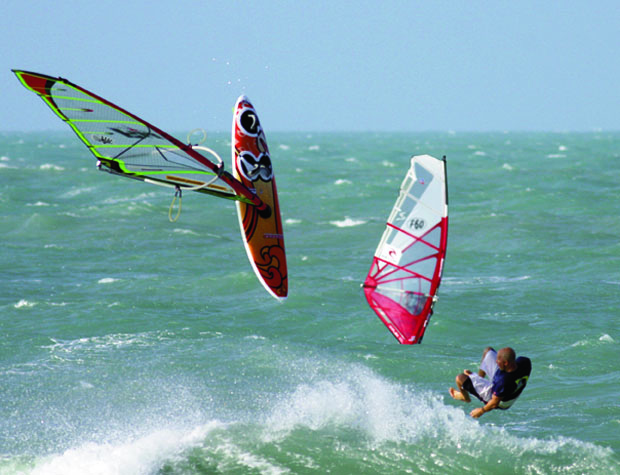
In the sequence above I was going up for a delayed forward on a 4.7 Ezzy Wave and RRD FSW 86 and I took off a bit close to the wind. Unfortunately we missed a couple of frames, but the sail started to backwind slightly so I thought “Oopsy… Time to get out.” These shots highlight that bailing out at the right time, in the right way (sound familiar?) will leave the kit out of harm’s way and it’s a fall and splash to the sea – no bombing or heavy petting though!
Tips
• Bail out at the right time.
• Push the kit downwind by throwing the rig downwind and kicking the feet out of the straps.
• Jumping with your toes down helps you get rid easier. That’s why I coached you to jump this way!
• Boots have a nasty habit of sticking in bailouts, and the ensuing claustrophobia can be nerve-wracking.
• Big straps and bare feet give you easier exit plans.
• You can actually choose to bail just the rig, and this is best just before you land by throwing it downwind.
• Or you can bail the board and float down under the rig, keeping it away on extended arms.
• Watch out for people coming in and out downwind of you – both when you bail and when other people might bail their kit on to you.
• Head upwind if you’re behind someone jumping on the way out, and when coming in give the jumper space downwind of you to jump / rotate / crash into.
ABORT!
Now let’s look at the right time to abort in different moves.
Basic Jump: If you’re totally out of control then get rid of your kit ASAP. If, however, you’re in control but about to crash or land too flat, then try and delay the bail so as to minimise swim time / kit loss and hitting other people (nasty!)
Forward: If you’re over-rotating and going to land flat I recommend letting go of the rig just as you land. When losing the board always follow through on the forward with the rig. If you’re going for a big delayed psycho death one and discover you’ve actually left your courage on the beach, then bail it at the top if you’re not happy.
Backies: In those over-rotated backies of death we’re looking to ban, bail as you come round before you spin around again. When it’s a sensible but overcooked one you can let go with your back hand and fall back just as you land. If you’re way under-rotated just kick your legs out of the straps and hold on underneath the boom. This also goes for a crashed tabletop – if you can get out!
Pushies: commit through the move, and if you’re going to land on the kit just relax your arms and brace for impact. You may be too committed and going into your second spin, so you’ll need to get long, extend your front arm and back leg, and even let go with the back arm.
RIDING: There are so many weird and wonderful ways to eat shit (or whatever else is floating in the sea) that we can’t give you all the tips here. So just be practical and get on the wave side of your kit whenever possible, or even lie on top of the boom. Where possible you need to keep hold of your kit – but not at any danger to yourself. Good judgement is the result of experience – which usually comes out of poor judgement! So the more wave time and the more you get punished the better you know how to avoid it or even survive it in the future. As your windsurfing skills progress you become much better at falling, and in such a way that you can recover as quickly as possible. So always plan ahead and keep working on that game plan.
Hall’s Homework:
To avoid those washings going out you will need to be very good at wobbling, so getting out in less than ideal conditions will really help with this. Also, a few sessions on a SUP works your core stability and balance massively and has a really strong skill transference to wavesailing. “If you don’t go you won’t know.” Anon

